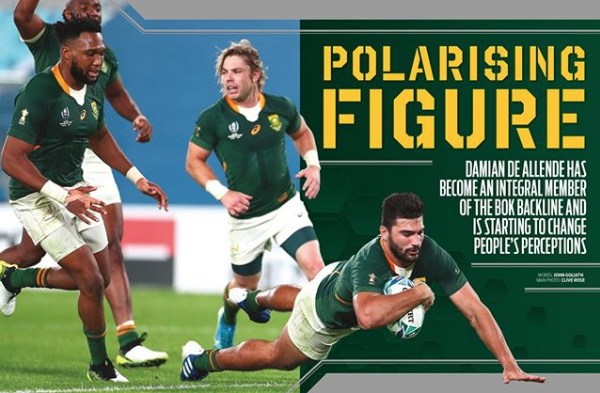Damian de Allende has become an integral member of the Bok backline and is starting to change people’s perceptions, writes JOHN GOLIATH.
The quote that ‘a prophet is not honoured in his homeland’ perfectly describes Damian de Allende’s love-hate relationship with South African rugby fans.
He is admired the world over and considered one of the best rugby players on the planet. But that point of view doesn’t seem to resonate on South African shores.
Before the World Cup semi-finals, WalesOnline picked the Bok inside centre as one of its players of the tournament, even comparing him to All Blacks legend Conrad Smith.
‘The choice of the centre may be strange for some, with his Springbok teammate Pieter-Steph du Toit, and New Zealand flanker Ardie Savea and outside-half Richie Mo’unga all having shone,’ the website stated. ‘But the powerful De Allende has been the Conrad Smith of this World Cup, the glue that has held together the South Africa midfield.
‘The 27-year-old does the basics so well, is a handful on the ball, can pass accurately and is a solid tackler who marshals the Springbok defence. If they are to go on and lift the World Cup for a third time, his quietly efficient role could be a key factor.’
But in De Allende’s home country, a lot of people would prefer to see him on the sidelines. Many are quick to label him a one-dimensional carthorse; a player who doesn’t offer enough on attack or create space for his outside backs. They regard him as a player who looks for contact without looking to offload.
The gripe probably stems from the fact De Allende has the tools to be a fantastic distributing inside centre, but doesn’t always showcase those attributes. There is no doubt he has a very good pass, and can also use his power and quick feet to motor through the defence and offload in the tackle.
But that is not the game the Springboks played under Rassie Erasmus at the World Cup, or in recent years for that matter. There aren’t any spectacular offloads or players trying to create space on a regular basis to exploit the outside gaps.
It’s a rigid plan and the rugby is sometimes frustratingly boring. But it’s brought success and given the Boks back the respect they lost over the past five years.
‘Everyone has labelled him and put him in a box, saying he is this one-dimensional player who only gets across the advantage line,’ says former Stormers coach Robbie Fleck, who coached De Allende from his U19 days at Western Province.
‘There’s no doubt he does that and he is really good at it. But there are subtleties to his game and skills that people don’t recognise and appreciate enough.
‘He is one of the best passers in the game. When he gets time and a bit of space he can put his outside backs away. ‘I guess he has been playing to a certain gameplan, but when he plays his game, he has the physicality and beautiful subtleties that don’t often get noticed,’ Fleck adds.
The Boks have relied heavily on their big forwards, good contestable kicks and a top defence. Sprinkle in a bit of X factor from the likes of Cheslin Kolbe and Makazole Mapimpi and you basically have the Boks’ blueprint.
But it’s those subtleties Fleck talks about that help you understated why De Allende is such a key component of that gameplan.
He has had to adapt his game for the greater good and Erasmus’ vision of how the Springboks must play. You could argue that De Allende had the same sort of role when Heyneke Meyer and Allister Coetzee had their turn at the helm, but he has grown into a much more rounded player under the current Bok management.
He is able to make metres for the Boks at close quarters, which is essentially his primary job. He is the Boks’ set-up guy, the man who needs to create that momentum for the South Africans to play from. He doesn’t often get the ball in space, so making an average of more than three metres per carry is a top effort. There is probably no better inside back in world rugby who can make that sort of distance from a standing start.
But the biggest improvement in his game has come in defence and at the breakdown. His work rate at the World Cup was particularly impressive. In the quarter-final against Japan, he was arguably South Africa’s best player, making an unbelievable 17 tackles. That’s just under one tackle every four minutes, which is insane for a backline player. He also created three turnovers, one of which saved a certain try when the Boks were playing with 14 men. In the same passage of play he also made a crucial tackle.
And despite often finding himself on the receiving end of criticism for a perceived tendency to take the ball into contact rather than distribute, De Allende openly addressed this subject before the Boks’ World Cup semi-final against Wales.
‘Sometimes it’s quite tough to make a 50-50 pass, because you know that if the pass doesn’t stick, you will probably concede seven, five or three points,’ he said. ‘You want to take a few risks now and then, if you really have to. If the opportunity is there and you feel like you can do it, then do it.
‘But I would say if you are in two minds and there’s a bit of doubt, rather tuck it and try to play one or more phases and see if you can break the defence and get over the advantage line.’
As fate would have it, De Allende put these words into practice with a match-defining try against Wales. With the score tied at 9-9 after 55 minutes of a tense semi-final, the burly centre received the ball from a standing start just inside Wales’ 22. He stepped off his right foot, feigned a pass, but then held the ball firmly under his left arm while using his right hand to fend off two defenders as he powered over the tryline.
At the end of the day, De Allende is basically a sort of hybrid player who plays centre but also as a de facto fourth loose forward. The Boks don’t have the biggest back three in the world, but they can afford to play those elusive speedsters on the wings because they don’t have to worry about being overrun in the wide breakdowns.
Turnover ball in today’s rugby is crucial because of the competitive defences. De Allende, with that ability to slow the ball down or ruck over the top of it, gives the Boks another attacking option from which to strike.
‘He is putting on a lot of pressure at the breakdown. He is not a natural stealer, but his counter-rucking and his decision-making at the defensive breakdown is excellent,’ Fleck says.
‘That sort of work goes unnoticed. His work rate off the ball, especially on defence is outstanding. He is a very good defensive player, and understands it well. He fills the gaps and has a massive appetite.’
New issue: How the Boks united a nation
De Allende also seems content with life, which Fleck believes is contributing greatly to his form.
He is playing like he belongs at this level of the game. He looks more comfortable in the Springbok jersey, which is normally quite a heavy burden because of the continued scrutiny and baggage that come with it.
‘When he is playing with confidence, he is unstoppable. When he is a bit frustrated he doesn’t play well. But you can see there is a quiet confidence about him at the moment. He is certainly a key player for the Boks.’
It wasn’t the case a few years ago after a breakout 2015 Super Rugby campaign. Injuries and a non-stop playing schedule resulted in a loss of form and confidence.
It took him a couple of years to rekindle the magic of 2015, when he dominated most of the attacking stats in Super Rugby, including tackle busts and offloads.
De Allende is back and playing some awesome rugby, as a much more mature and, definitely, more rounded player.
‘Thankfully I haven’t been injured in the past two years,’ he said. ‘When you get going like that and you build momentum over such a long period of time, the hard work does start paying off. I wouldn’t say I’m in the best shape, but I’m enjoying myself.
‘I had to work harder. I got the balance right in understanding the gameplan properly. I know where I see myself to be able to put myself in better positions.’
Hopefully when he gets home from the World Cup people will show him a lot more appreciation and respect … perhaps as much as the rest of the world does.
*This article originally appeared in the December issue of SA Rugby magazine, on sale now!





